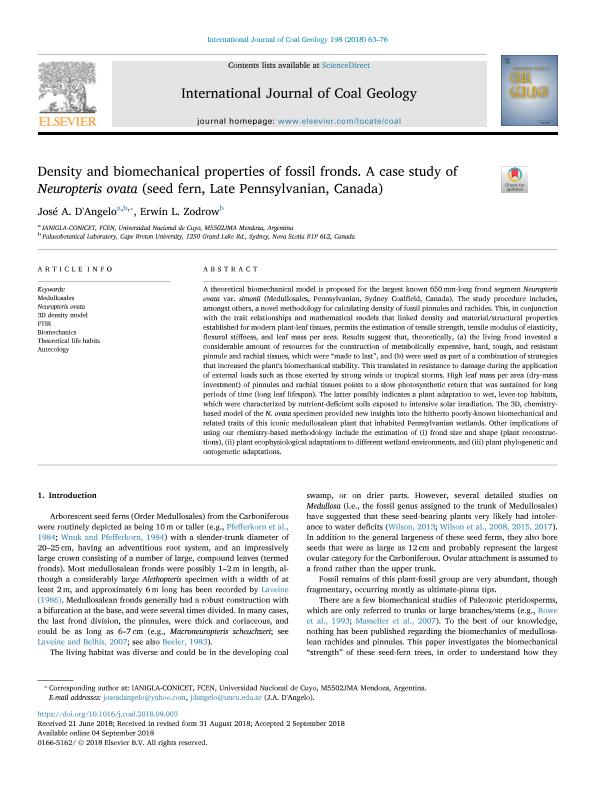Mostrar el registro sencillo del ítem
dc.contributor.author
D`angelo, José Alejandro

dc.contributor.author
Zodrow, Erwin L.
dc.date.available
2019-10-23T18:41:22Z
dc.date.issued
2018-10
dc.identifier.citation
D`angelo, José Alejandro; Zodrow, Erwin L.; Density and biomechanical properties of fossil fronds. A case study of Neuropteris ovata (seed fern, Late Pennsylvanian, Canada); Elsevier Science; International Journal Of Coal Geology; 198; 10-2018; 63-76
dc.identifier.issn
0166-5162
dc.identifier.uri
http://hdl.handle.net/11336/87122
dc.description.abstract
A theoretical biomechanical model is proposed for the largest known 650 mm-long frond segment Neuropteris ovata var. simonii (Medullosales, Pennsylvanian, Sydney Coalfield, Canada). The study procedure includes, amongst others, a novel methodology for calculating density of fossil pinnules and rachides. This, in conjunction with the trait relationships and mathematical models that linked density and material/structural properties established for modern plant-leaf tissues, permits the estimation of tensile strength, tensile modulus of elasticity, flexural stiffness, and leaf mass per area. Results suggest that, theoretically, (a) the living frond invested a considerable amount of resources for the construction of metabolically expensive, hard, tough, and resistant pinnule and rachial tissues, which were “made to last” and (b) were used as part of a combination of strategies that increased the plant's biomechanical stability. This translated in resistance to damage during the application of external loads such as those exerted by strong winds or tropical storms. High leaf mass per area (dry-mass investment) of pinnules and rachial tissues points to a slow photosynthetic return that was sustained for long periods of time (long leaf lifespan). The latter possibly indicates a plant adaptation to wet, levee-top habitats, which were characterized by nutrient-deficient soils exposed to intensive solar irradiation. The 3D, chemistry-based model of the N. ovata specimen provided new insights into the hitherto poorly-known biomechanical and related traits of this iconic medullosalean plant that inhabited Pennsylvanian wetlands. Other implications of using our chemistry-based methodology include the estimation of (i) frond size and shape (plant reconstructions), (ii) plant ecophysiological adaptations to different wetland environments, and (iii) plant phylogenetic and ontogenetic adaptations.
dc.format
application/pdf
dc.language.iso
eng
dc.publisher
Elsevier Science

dc.rights
info:eu-repo/semantics/openAccess
dc.rights.uri
https://creativecommons.org/licenses/by-nc-nd/2.5/ar/
dc.subject
3D DENSITY MODEL
dc.subject
AUTECOLOGY
dc.subject
BIOMECHANICS
dc.subject
FTIR
dc.subject
MEDULLOSALES
dc.subject
NEUROPTERIS OVATA
dc.subject
THEORETICAL LIFE HABITS
dc.subject.classification
Paleontología

dc.subject.classification
Ciencias de la Tierra y relacionadas con el Medio Ambiente

dc.subject.classification
CIENCIAS NATURALES Y EXACTAS

dc.title
Density and biomechanical properties of fossil fronds. A case study of Neuropteris ovata (seed fern, Late Pennsylvanian, Canada)
dc.type
info:eu-repo/semantics/article
dc.type
info:ar-repo/semantics/artículo
dc.type
info:eu-repo/semantics/publishedVersion
dc.date.updated
2019-10-16T20:59:10Z
dc.journal.volume
198
dc.journal.pagination
63-76
dc.journal.pais
Países Bajos

dc.journal.ciudad
Amsterdam
dc.description.fil
Fil: D`angelo, José Alejandro. Universidad Nacional de Cuyo; Argentina. Consejo Nacional de Investigaciones Científicas y Técnicas. Centro Científico Tecnológico Conicet - Mendoza. Instituto Argentino de Nivología, Glaciología y Ciencias Ambientales. Provincia de Mendoza. Instituto Argentino de Nivología, Glaciología y Ciencias Ambientales. Universidad Nacional de Cuyo. Instituto Argentino de Nivología, Glaciología y Ciencias Ambientales; Argentina
dc.description.fil
Fil: Zodrow, Erwin L.. Cape Breton University; Canadá
dc.journal.title
International Journal Of Coal Geology

dc.relation.alternativeid
info:eu-repo/semantics/altIdentifier/doi/http://dx.doi.org/10.1016/j.coal.2018.09.003
dc.relation.alternativeid
info:eu-repo/semantics/altIdentifier/url/https://www.sciencedirect.com/science/article/pii/S0166516218305809
Archivos asociados
